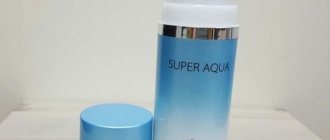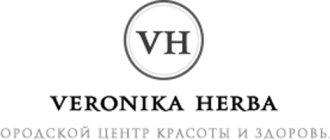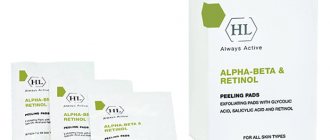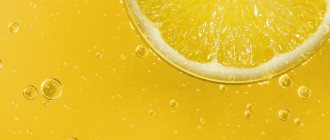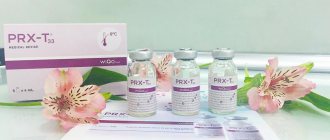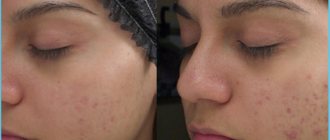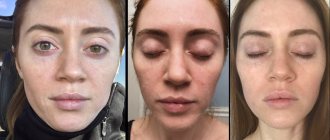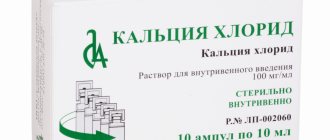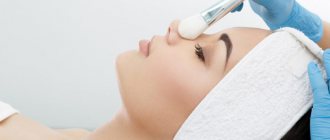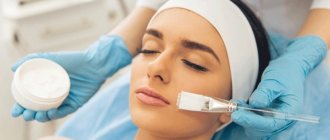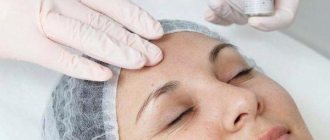Jessner peeling (Hollywood peeling) is a procedure that allows you to intensively exfoliate dead skin to stimulate its renewal and eliminate some defects. It should only be carried out under the close supervision of a specialist. Due to the influence of active substances, a pronounced rejuvenating effect is observed, which can subsequently be maintained without much effort.
The principle of Jessner chemical peeling - key features of the procedure
Jessner peeling, similar to any other cosmetic procedure, involves several stages of implementation:
- The master determines the individual intolerance of the composition by the client’s body.
- Next, the skin is cleaned, usually using a special solution that provides a disinfecting effect, removing residual sebum.
- After the cleaning procedure, the peeling solution is carefully applied using a cotton or gauze swab. It is quite normal to experience a burning sensation throughout the procedure as the top layer of skin is removed. Mild discomfort is certainly present, but is fully compensated by the result of the procedure.
- Applying a special solution to neutralize the effect of the solution, removing any remaining product.
Within a week after the procedure, there will be a problem of skin redness, peeling, followed by peeling off in layers. Such changes are actually something to keep in mind because not everyone is ready to go outside with such changes. But it’s worth being patient for a week to achieve the complex effect of complete skin renewal, gaining an image of beauty, health and youth. After 2-3 weeks, it is recommended to repeat the procedure. This course is carried out 4-5 more times to consolidate the effect. However, the duration of the course is determined individually for each client; for many, 2-3 procedures are enough.
Have you decided to undergo a chemical facial peel? - be sure to read!
Oh, this peeling - there are so many conflicting reviews on the Internet: for some it is salvation, for others it is several days of discomfort, and still others consider this facial care procedure to be useless.
Let's try to figure it out.
Chemical peels are one of the popular facial care procedures provided by institutions with a valid license to provide medical services (why with a license - just below). They are effective and relevant both at a young age in the treatment of acne and oily skin, and at a mature age - to combat dry facial skin, pigmentation, wrinkles, and as anti-aging preventive procedures.
We have already discussed the differences between peelings and recommendations for use in our other articles, but let's repeat:
As you know, skin cells originate in the basal layer of the epidermis, and gradually rise to the stratum corneum, after which they die and peel off. In this process, skin peeling acts as a tool for removing dead cells.
There are several types of chemical peeling:
Superficial - impact on the surface of the epidermis, at the level of the stratum corneum. Usually used for still young, young skin as a cleanser or solution to specific aesthetic problems, often these are peelings with alpha hydroxy acids (AHA, pyruvic, salicylic and fruit acids)
Medium - exposure in the middle of the epidermis, where layers of living cells are already affected. This type of peeling usually causes severe peeling, redness and requires a recovery period. It is used to solve specific problems and combat age-related changes in the skin, as well as post-acne, pigmentation, expression wrinkles, small stretch marks, scars - peelings with TCA (trichloroacetic acid), 30% salicylic acid are used, including and Jessner peel.
Deep - affects all layers of living cells, down to the basal layer, partially damaging the basement membrane. It is considered an operation and is comparable to a 3rd degree burn. The rehabilitation period can last up to six months, but the effect will last up to several years. It is used for radical correction of age-related changes: removal of deep wrinkles, scars - this is, for example, phenol peeling, peeling with trichloroacetic acid in high concentration.
Chemical peeling is essentially a controlled chemical burn of the face using a gel, cream or solution based on acids, which, depending on the type, concentration and time of exposure, improve the condition of the skin:
- The bridges between cells (desmosomes) are dissolved. As a result, dead cells are exfoliated, and the epidermal barrier is not broken.
- Stimulate cellular restoration - when the upper stratum corneum is destroyed, the cells of the lower basal layer begin to actively divide.
- Stimulate fibroblasts and promote the synthesis of hyaluronic acid, collagen, elastin.
- Under the influence of acids, the stratum corneum decreases and the thickness and density of the dermis increases - the skin becomes firmer and more elastic, wrinkles are smoothed out.
- They attract water and deliver it to the epidermis, moisturizing the skin, cleanse pores and normalize the activity of the sebaceous glands, thereby reducing oily skin and preventing the appearance of acne.
- They provide an antioxidant effect and reduce the activity of the tyrosinase enzyme, which in turn suppresses melanin synthesis and leads to skin lightening.
It is precisely because of these properties of the effect of acids on the skin that there are many indications for the use of chemical peeling. Chemical peeling helps solve a very wide range of cosmetic problems:
- Hyperpigmentation.
- Wrinkles.
- Dehydration.
- Dryness.
- Hyperkeratosis.
- Seborrhea.
- Acne.
- Post-acne.
- Rosacea.
- Scarring.
- Stretch marks.
- Prevention of aging.
But at the same time, there are contraindications, even for the mildest and most superficial peeling:
- Violation of the integrity of the skin (injuries - wounds, scratches, cuts, etc.).
- Invasive procedures performed less than 2 months ago (deep cleaning, mesotherapy, laser resurfacing).
- Active inflammatory process.
- Pronounced rosacea.
- Pregnancy, lactation.
- Fever, cold.
- Any chronic and acute skin diseases, infectious skin diseases.
- Herpes in the active phase.
- Asthma.
- Hypertension.
- Oncology.
- Taking medications that increase sensitivity to the sun, immunosuppressants.
- Prolonged exposure to the sun and a fresh tan.
- Hormonal disorders
- Individual allergic reactions caused by intolerance to components and compounds in cosmetic products.
!!! To avoid discomfort and complications both during the peeling procedure and after, be sure to follow all the instructions of a cosmetologist, and do not ignore pre-peel preparation and post-peel skin care.
As we said earlier, chemical peeling is an operative procedure. Unfortunately, even the most highly qualified specialist - cosmetologist, when performing chemical peeling, cannot guarantee and foresee all the consequences of the effects of the drugs used, largely due to your individual characteristics and the state of the body at the time of the procedure.
The result of peeling (including the rehabilitation period), like the result and consequences of many other skincare procedures, is individual , which is why we can so often come across completely different (both positive and negative) reviews about this procedure. Of course, our Center also faces such situations. For example, when providing superficial peeling services using a drug that is quite popular today, and very loved by our cosmetologists because of its high efficiency and short rehabilitation period, like PRX-T®33, a frequent Client of our Center was faced with exactly this situation - a complete recovery period lasted up to three weeks. Of course, we regret this situation, but, as the manufacturer states, PRX-T®33 is a comprehensive program of professional procedures and home care for active natural restoration and rejuvenation of the skin, as a result of which the epidermis is not damaged, but new collagen is formed and the structure is renewed cells, penetrating to the papillary layer of the dermis, triggering a cascade of reactions, deeply stimulating the skin. The drug has an international patent for a unique formula after 10 years of clinical trials, more than 100 scientific studies have been conducted proving the effectiveness of the drug and more than 100 million procedures, it is safe to use even at home, there are no seasonal restrictions, the procedure takes place without much pain and has no rehabilitation period. But, even with such characteristics of the drug, after its use there may be deviations associated with your individual characteristics and skin reactions, which the specialist performing the procedure cannot determine in any way; accordingly, the rehabilitation period can be increased.
!!! In this regard, we strongly advise you to take a thorough and balanced approach to making the decision to undergo a chemical peeling procedure and be prepared for the need to carry out the procedure in a course with a stronger concentration of the agents used or, conversely, for an increased rehabilitation period after the chemical peeling procedure, as well as the maximum inform the specialist about any individual or previously encountered allergic reactions to certain cosmetics and medications, about the cosmetics used and the current state of the body.
During a chemical peel procedure, the following are often possible:
- increased skin sensitivity (due to thinning of the epidermis);
- skin redness;
- a feeling of dryness, tightness, tingling up to a slight burning sensation, peeling of the skin;
- rash (for example, with acne this is normal, their number gradually decreases and finally disappears).
Pre-peeling preparation
- Adapts the skin to the effects of acids, evens out the upper layer of the epidermis, which ensures better and more uniform penetration of the peeling.
- To prepare for 2 weeks before starting the peeling course, use cosmetics with a small percentage of acids - cleansers, serums, creams with an acid content of 6-12% and a fairly high pH.
- So, for AHA acids, the minimum effective indicators for a daily product are 5-8% at pH 3-4, and for BHA acids (salicylic) - 1-2% at pH 3-4.
Post-peeling care
- For 2 weeks after the chemical peel procedure, use the same daily products with a small percentage of acids as during the pre-peel preparation. Use soothing, healing, restorative, therapeutic post-peeling masks, serums and creams. This will help avoid complications, soothe the skin, speed up regeneration and saturate the skin with active ingredients as much as possible.
- Choose products from the list prescribed by your cosmetologist and strictly follow his recommendations.
We hope that now you understand why most cosmetology services , including peelings, are included in the list of works (services) that constitute medical activities and are subject to mandatory licensing (Resolution of the Government of the Russian Federation of April 16, 2012 N 291 On licensing of medical activities) . The Beauty and Health Center “Philosophy of Excellence” has the appropriate license and has the right to provide this type of service.
The presence of this license imposes certain obligations on the institution, including on staff in terms of its level of education.
Thus, the minimum requirements for a specialist performing chemical peeling, according to the order of the Ministry of Health and Social Development of the Russian Federation dated April 18, 2012 N 381n (On approval of the Procedure for providing medical care to the population in the field of cosmetology) and order dated October 13, 2022 N 804n (On approval nomenclature of medical services) is the presence of additional education - professional retraining in the specialty “Nursing in cosmetology” with secondary vocational education in one of the specialties: “General Medicine”, “Midwifery”, “Nursing”.
A cosmetology nurse must have:
- depilation techniques with wax, sugar, cosmetics;
- care techniques, which include: massage (face, body, anti-cellulite, medical), skin cleansing (chemical or mechanical abrasive peeling), wraps and masks; techniques used in cryotherapy (when the body is exposed to low temperatures in order to achieve a rejuvenating effect);
- injection techniques: mesotherapy (intradermal injection of nutritional cocktails of vitamins and biologically active substances), botulinum therapy, contour plastic surgery, PRP technologies; hardware procedures - laser and photoepilation, vacuum massage, etc.;
- first aid techniques in case of allergic reactions in a patient.
!!! Therefore, even if a specialist has a certificate of completion of any courses in peeling techniques, but does not have the appropriate education, such a specialist does not have the right to provide this type of cosmetic procedures, even if the institution is licensed to provide medical services in the field of cosmetology. Unfortunately, few people know about this nuance, which unscrupulous beauty salons and private masters take advantage of by providing their clients with such certificates, which in fact do not give either the right to provide such a service or confirm the required educational minimum, thereby putting their client’s health in danger.
At the Philosophy of Excellence Beauty and Health Center, all employees have the appropriate education - we strictly comply with all the requirements of the licensee and take care of the health and safety of our Guests. You can always view information about the education of our employees, as well as other information required to be published by a medical institution, on our website.
Dear girls, women! Be careful in choosing an institution and a specialist when deciding to undergo a chemical peeling procedure! Taking care of your health, Beauty and Health Center “Philosophy of Excellence”.
You may be interested in this:
Choosing a beauty salon after quarantine is lifted
How to choose your center / beauty salon Beauty salons, cosmetology rooms, spa centers and health centers
Jessner peeling is carried out in two levels. The procedure can be median or superficial:
- Superficial - the procedure is based on applying only one layer of solution, keeping it on the surface for a short time to ensure deep penetration into the composition of the epidermis. As a rule, a procedure is performed to prepare the skin for medium peels. The skin after the superficial procedure does not imply significant peeling.
- The middle procedure is working with three or more amounts of solution. In this case, the skin after peeling begins to turn red, the next day it completely acquires a brown tint, covered with a crust or film, with tightening, with severe peeling and flaking after a few days.
How often can you do it
A course of procedures is required to achieve the desired lasting effect. The number and frequency of sessions is determined by a specialist, based on the condition of the epidermis. Also takes into account age and purpose.
For sensitive skin, 5-6 sessions are usually prescribed. For problematic oily skin, you need 8 to 10 repetitions. Between visits to the beauty salon, you should take breaks of 3-5 weeks. The first time there will most likely be one or two layers.
The effect lasts for some time. For most, the ideal look lasts up to 6 months. Others enjoy smoothness and shine in just 10 days. Much depends not only on the quality of the components and the skills of the craftsman, but also on subsequent care. It is important to follow the recommendations so that the result lasts as long as possible.
Features and rules of care after Jessner peeling
To achieve the desired effect, it is important not only to the quality of the procedure, but also to proper care after peeling. To do this, the cosmetologist explains in detail to the client the step-by-step procedure, with recommended products and preparations for caring for the skin condition.
- Be sure to strictly follow the recommendations and instructions of the cosmetologist.
- After peeling, it is unacceptable to wash your face for 12 hours.
- Usually, a cosmetologist individually selects a set of products for intensive moisturizing and gradual restoration of the skin - the most important point for the desired effect, which should not be neglected.
- Only boiled water is suitable for washing; the surface of the skin should be wiped with blotting movements.
- You should temporarily abandon standard cosmetics and homemade masks. The bet should be made in favor of restorative, wound-healing creams and serums.
- The option of sunbathing is unacceptable; you can walk outside only if you apply a UV filter to your face with a high protection factor.
Contraindications for use
Before the procedure, a consultation with a cosmetologist is required, who will assess the condition of the skin and confirm the absence of restrictions, because Jessner peeling has the following list of contraindications:
- rosacea;
- autoimmune disorders;
- oncological pathologies;
- period of pregnancy and lactation;
- infectious and viral dermatological diseases (herpes, etc.);
- damage to the skin and neoplasms (abrasions, scratches, papillomas, local purulent inflammation, warts);
- allergic reactions to the components of the product;
- endocrine diseases (diabetes mellitus, etc.);
- elevated body temperature and other symptoms of ARVI;
- taking drugs of the retinoid group (Roaccutane, etc.).
Opinion of cosmetologists
Doctors are positive about using the procedure using the Jessner composition. The option gives tangible results; there are formulations that bring minimal discomfort. Prescriptions are made according to indications; some offer more gentle options.
The cosmetologist recognizes the danger of this option and is in no hurry to prescribe Jessner peeling.
The cosmetologist speaks positively about the results of Jessner cleansing.
The cosmetologist praises the product with a composition that has minimal side effects.
Patient reviews
Opinions about the option vary. Some patients notice dramatic results, repeatedly turn to Jessner peeling, and recommend others to try it. There are patients who expect more or do not see positive changes as a result of the intervention.
The patient does not notice the result of the procedure.
The patient liked the result and recommends the option.
